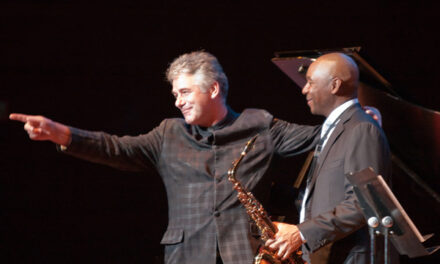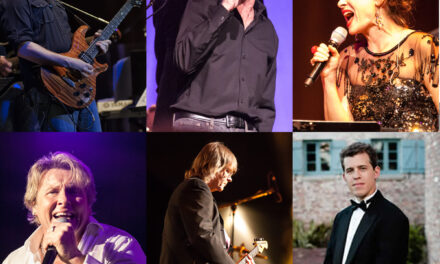Ever since Elon University has been lucky enough to present the Adams Foundation Piano Recital Series, its soloists have ranged from the long-established (such as Ann Schein and Ruth Laredo) to recent prize winners (such as Cliburn gold medalist Jon Nakamatsu) to outstanding younger talents (such as Steven Mayer). On October 30, a large audience in Whitley Auditorium heard yet another superb multi-talented musician, Robert DeGaetano, in a broad survey of compositions by keyboard virtuosi. Besides possessing a mean set of chops, DeGaetano is an accomplished composer.
High on every music lover’s list is the Sonata No. 14 in C-Sharp Minor, Op. 27/2 (“Moonlight”), by Ludwig van Beethoven (1770-1827), which opened DeGaetano’s recital. The interpretation was well within current standards for classical style. The magical slow opening movement was ideally paced with refined timbres. The explosive sforzandi over the course of the headlong dash of the last movement were just some of the examples of Beethoven, the master of surprises, to which DeGaetano gave special attention. Avoiding any attempt to suggest a period instrument, DeGaetano made full use of the resources of Elon’s beautifully-restored Steinway piano.
DeGaetano said that his own work, “Forgiveness,” Op. 7/9, was written during extended stays in the Catskills over a three year period, a time of reflection and of extensive composition. The work is tonal with very long-breathed melodies over a repetitive base figure.
Four well-selected pieces, all immediately recognizable to most music lovers, served to explore the sound world of Frederic Chopin (1810-49). Throughout the concert, DeGaetano prefaced each major work or set with a few well-chosen words about the changes to keyboard style brought about by each composer. The Fantaisie-Impromptu in C sharp minor was an especially apt selection since it is believed that Chopin had withheld its publication because he felt it too closely resembled Beethoven’s “Moonlight” Sonata. DeGaetano wove a magical spell from the work’s many cross-rhythms and the ceaselessly moving note figuration right up to its ambiguous, quiet ending. Chopin composed his “Revolutionary” Étude (Op. 10/12) around the time of the failed November Uprising in his native Poland in 1831. Unlike the other eleven of the first set of études, which explore particular keyboard techniques, No. 12 is a free-standing concert work that explodes with passion, echoing the sounds of combat. DeGaetano brought out the unique combination of melancholy and seamless melody in the Nocturne in E-flat, Op. 9/2. The one draw-back of Whitley Auditorium is its closeness to regularly traveled railroad tracks. With the power and swagger that DeGaetano brought to the “Heroic” Polonaise in A-flat, Op. 53, he soared over the rumblings of the 8:30 p.m. freight train! Score one each for musician and composer.
DeGaetano said Serge Prokofiev (1891-1953), unlike earlier composers, reveled in treating the piano as a percussion instrument instead of creating the illusion of a melody instrument. This is especially true of his three War Sonatas, numbers 6 through 8. The first and last movements of the Sonata No. 7 in B-Flat, Op. 83, are dramatic, with the explosive attacks evoked in the latter. According to DeGaetano’s program note for his CD recording, the middle movement recalls the singing of “Marlene Dietrich expressing all the human horrors of war.” DeGaetano used a wide variety of dynamics to fulfill Prokofiev’s nightmare vision of man-made hell.
The keyboard firebrand Franz Liszt (1811-86) was represented by a quiet piece — “Liebestraum,” a transcription of one of his own songs. DeGaetano balanced melody ideally without straying into sentimentality.
DeGaetano said that. in listening to recordings of Serge Rachmaninov playing his own compositions, he had found a unique sound unlike any contemporary pianist. He asked composer Samuel Barber about it and the latter consulted Vladimir Horowitz, who in turn recommended that DeGaetano consult with Olga Stroumillo, who had been Rachmaninov’s assistant during the 1930s. DeGaetano learned from her how to replicate the thick, almost orchestral sound the Russian brought to the piano. Three selections — the well-known Prelude in G Minor, Op. 32/5 and the Études-Tableaux in E-flat Minor, Op. 39/5 and in D, Op. 39/9, — gave DeGaetano ample scope to display his mastery of the plush, rich Rachmaninov sound along with a broad palette of tone color.
DeGaetano chimed in with Liszt’s “La Campanella” as an encore to end a delightful and informative recital. He has eight CD recordings on the Crystonx label covering most of the great piano virtuosi-composers.












